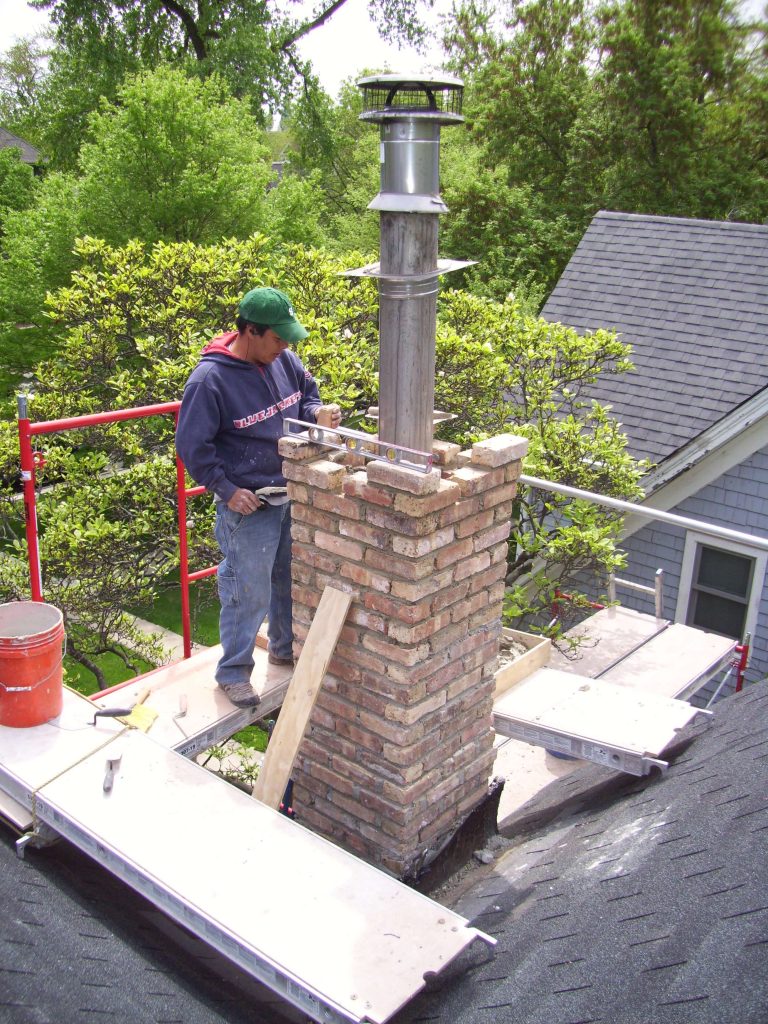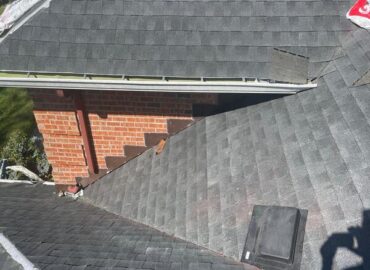What is a Chimney Cricket’s Purpose?
How does this mini-roof on the backside of your chimney keep water out? Without the chimney cricket, this area would be nothing more than a downward slope of the roof that creates a fissure against the chimney, ideal for water to gather.
Pooling water in any part of your home is never a good thing, and there’s a good reason for that. Water will enter the brick masonry and roofing system if it collects and lingers behind your chimney. As you might expect, water that penetrates into your chimney and into your roof’s underlayment will wreak havoc and cause a lot of damage over time.
Water chooses the path with the least amount of resistance. Water is pushed to slope down the roof and be diverted out through the gutter system when a chimney cricket is installed. There isn’t any pooling water, thus there isn’t any water damage.
Stainless steel, aluminum, and galvanized steel are used to make chimney crickets. Chimney crickets blend well in with the rest of the roof’s shingles. Most roofing contractors give homeowners extra shingles anyhow, so if a chimney cricket needs to be installed or repaired, the same shingles will be used.
Protection on two levels
The chimney cricket’s main function is to properly divert water away from the roof and into the gutter system. However, having a chimney cricket comes with an added benefit: greater protection. Skilled and experienced contractors will ensure that an ice shield is installed behind the cricket, knowing that even if water is forced to run off in normal conditions, the water may freeze before it is routed away in exceptionally cold weather. This is a common area for ice to build, but an ice shield made of synthetic felt will give your roof an extra layer of protection.
Installing a leak protection barrier at the chimney cricket is also something that experienced contractors are aware of. Despite the fact that the cricket’s peaked roof will keep water out, a leak prevention barrier should be installed. The ice shield will be installed on top of the leak protection barrier by the contractor. You’ll have three levels of protection against water damage after the shingles are installed on top of the system.
What Happens If There Isn’t a Chimney Cricket?
Water can cause harm to your property in unexpected ways. Foundational concerns, fractured masonry, mold and mildew, leaking attics, and other structural issues are all common problems caused by water damage.
Issues with the Structure
Water damage can be difficult to detect, but if it has been present for a long time, you may discover stains on your walls. Ceilings and near windows may have discolored walls (or, if you have wallpaper, the staining might discolor the wallpaper and the glue beneath it, causing it to no longer lay flat). Window and door frames may also show signs of warping.
These structural problems can be caused by untreated water damage. Water may cause havoc within your home’s walls and foundation, from the very top to the very bottom. This is why having a healthy roofing system is critical to your home’s overall health, and while a chimney cricket is a minor feature, it provides significant protection.
Drips and Leaks
During heavy rains, your attic or basement may become moist, and you may notice water dripping through the roof. Leaks can cause your home’s structural integrity to deteriorating. If your attic is leaking, water damage to your hardwood rafters is a possibility. The foundation of your home can deteriorate, break, and shift if your basement walls are leaking and aren’t waterproof.
Two key methods for preventing leakage, dripping, and water damage are the use of a chimney cricket and a properly working roof system.
Ice dams are a type of ice dam that forms
During the winter months, if you don’t have a chimney cricket, you’ll have snow and ice forming behind your chimney. If you don’t clear the snow and the temperature drops below freezing, the water from the runoff might quickly refreeze, resulting in a dangerous ice dam. Ice dams are quite harmful.
These thick sheets of ice keep water off the roof and into the gutters, away from the home and foundation. The additional weight on the roof is also bad for the roofing system. Recurring ice dams put additional strain on a roofing system, causing shingles and underlayment to deteriorate. The sheets of ice may slip off in some situations, posing a risk of injury.
Small Cricket, Massive Defense
Even if the chimney cricket appears little, you already know it’s an important part of a properly kept and operating roofing system. If there isn’t cricket in place to separate the water and divert it off the roof, that gap between your chimney and roof can be dangerous. The cost of cricket is a tiny fee to pay to avoid costly flood damage.


